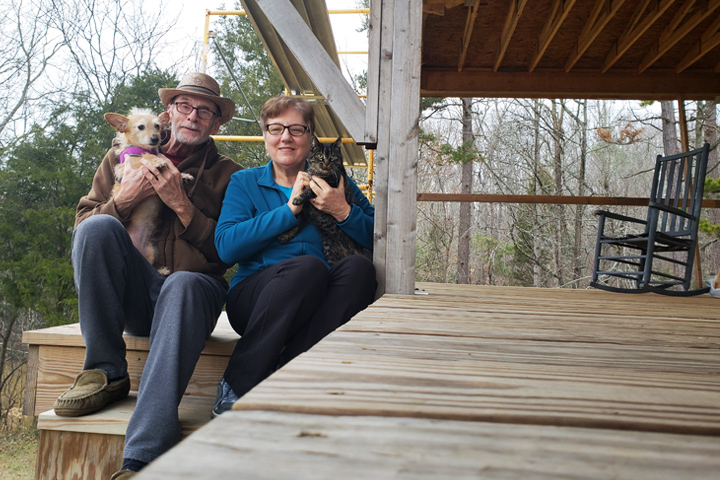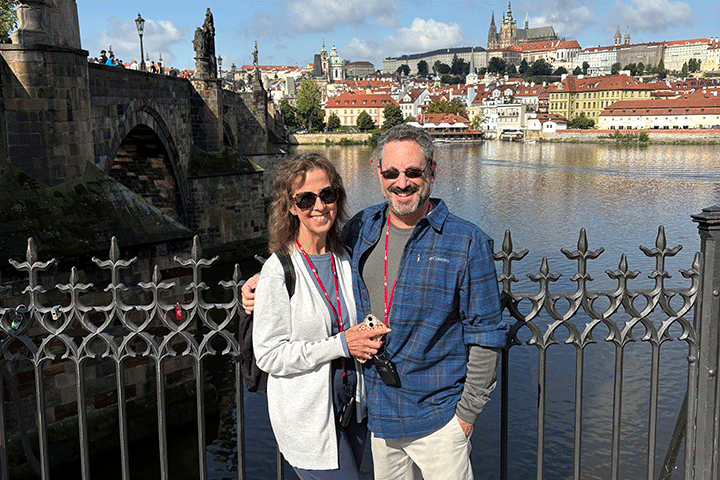After Surviving Pancreatic Cancer, a Moral Obligation to Share

- After stage IV diagnosis, limited treatment options
- Tumors respond to chemotherapy, paving the way for surgery
- Liver lobe removal and Whipple procedure
I am writing my story to document my survival of pancreatic cancer and fulfill what I believe to be my moral obligation to share this knowledge with anyone that it can help.
I was diagnosed on April the 2nd, 2012, with pancreatic cancer. It was stage IV due to the fact that it had spread from my pancreas into the liver. There were six tumors of various sizes in the right lobe of my liver and one small tumor in the left lobe. I was given two months to live with no hope for a cure. I decided to fight despite the experts’ predictions, as I was not about to lay in bed in wait for death to take me away.
Treatment Before Surgery
I chose to go to Duke University Medical Center, in Durham, North Carolina, because I didn’t have much time and it was fairly close by. At Duke I met with the oncologist Dr. John Strickler. He agreed to go against protocol and help me with my attempt at survival. He made no promises, just told me the facts and away we went.
First many tests, scans, and evaluations. I was told that I was inoperable. The specific type of pancreatic cancer was high grade (meaning that it was extremely aggressive), poorly differentiated neuroendocrine. Turns out that this type is one of the most rare. I thought this would be even more difficult to beat, as it stood to be the one that would likely get very little, if any, research.
Dr. Strickler searched online for possible avenues of treatment and came up with the option of FOLFIRINOX, a concoction of chemotherapies. His rationale was that it had been shown to kill the cancer cells as they were dividing and since my cancer was so aggressive the cells must be constantly dividing. I liked the reasoning and said “Let’s go for it.” He replied that we had only enough time for this one attempt. He called it a “Hail Mary pass.”
After four rounds of FOLFIRINOX, I was given a CT scan. The results were amazing. All tumors were reduced in size by 60 to 70 percent. At that time the surgeons said that maybe they could operate. I was constantly doing research all the while undergoing the treatment, and read about saving the pyloric sphincter and pylorus. I asked if this was possible for me, but the surgeons thought it was not. I decided to stay on the chemo a while longer. As it turned out, a while longer turned into 15 total rounds of chemotherapy.
The first round of chemotherapy was the worst. I just felt really yucky on day three and four after the chemo. To prevent constipation, I started eating prunes a couple of days before each round of chemo. Instead of two really rotten days, I had only one not so good day. Peripheral neuropathy was another side effect but it slowly subsided after I stopped having chemo.
Looking For Other Treatments
While I was undergoing chemotherapy, I consulted doctors at MD Anderson (Houston, Texas) and the Moffitt Cancer Center (Tampa, Florida)—both supposedly have some of the best people in the United States to treat this type of pancreatic cancer. They all offered no other hope.
On around the 1st of December I arrived at Wake Forest Medical Center in Winston-Salem, North Carolina, to speak with Dr. Brian Kouri, an interventional radiologist. He performs a procedure called radiofrequency ablation by which a needle is inserted into the tumor and energized with a radio transmission signal which generates heat. If the temperature of the tumor is raised to 50 degrees Celsius or higher the tumor will be killed. And if the temperature is kept below 70 degrees Celsius, the healthy cells will not be harmed. I thought this would be the answer—if I could save my liver and then have my pancreas removed I would be cured. You see, my goal was to live long enough for science to discover The Cure.
Before my appointment I sent Dr. Kouri all of my medical records, so he had already reviewed them when I walked into his office. He asked, “What are you doing here?” I replied that I was trying to get rid of these tumors in my liver. He said that I should talk to their surgeon and he would set up the appointment.
A couple of days later I met with Dr. Clancy Clark, a specialist in liver surgery and the Whipple surgery. At first we made small talk, mostly about classic cars. Then we started talking about surgery. I explained to him that the surgeon at Duke told me that I would need two surgical procedures—first on my liver, and then after I recovered I would have the Whipple procedure. I would have to be off my chemotherapy during this entire process. I was worried about keeping the cancer in check during this time, so Dr. Clark suggested radiation, but I was concerned about the radiation causing heart problems later. He finally said, “What if we do the liver and the Whipple at the same time?” I replied, “Boy, that would be great and I won’t have to recover but once. But I have two requests. I want to keep my pylorus and pyloric sphincter.” He said, “No problem.”
Dr. Clark asked, “What’s the other request?” I explained that I read that Dr. Perry Shen at Wake Forest is one of the best when it comes to the Whipple procedure, and I wanted to know what he thought about this idea. A couple of days later I met with Dr. Shen. He said, “OK here’s what we are going to do. If we can do the liver in three hours then we will proceed with the Whipple. The surgery is scheduled for January 23, 2013.” HOW GREAT IS THAT?!!
Pre-Surgical Biopsy Brings Surprising News
Dr. Strickler was delighted when he heard that I was going to have surgery. He had encouraged me not to miss my window of opportunity for this. Before surgery I had another biopsy, since I had used all of the previous material on the trips to MD Anderson and Moffitt. During the procedure the technicians tried to take samples of my tumors, but we were all in for a surprise. The doctor looked at the sample under the microscope and said, “There is no cancer here.” She saw some cells that looked odd but no cancer. The same thing happened with my other tumors—they could not get a viable biopsy. Then it hit me, this cancer is already dead!
Time For Surgery
I had learned that your best chance for a cure was surgery if the cancer was caught early but my cancer was not caught early. And when I first started this journey I really didn’t want surgery—I didn’t want to be gutted like a fish. But when I was finally able to have surgery I was so looking forward to it, like a kid waiting on Santa Claus.
That big day finally arrived. The last thing I remember until the next day was being rolled into the operating room. The original plan for the liver was to remove the individual tumors, but because they could not be found, the doctors decided to remove the entire right lobe. The one small tumor in the left lobe also could not be found. They did the Whipple procedure. The whole surgery took about ten and a half hours.
The most amazing part of this story is that when the tumor tissue was sent to pathology for analysis, all the tumors in the liver and the initial tumor in the head of the pancreas were found to be dead in the aftermath of the chemo. There was one extremely small almost microscopic spot of live cancer cells in the pancreas but the margins—the edge or border of the tissue removed in cancer surgery—were clear. No cancer was found there. And even more astounding is the fact that all of the 15 associated lymph nodes removed were found to be clear.
Recovery was tough but I had no pain, thanks to a pad with small needles attached to my back. I did get an infection stemming from the stent that had been placed in the bile duct. And it took a long time for my appetite to come back. I had to make myself eat.
I am fine now and eat like a horse. I worried that I could be rendered diabetic but I am not. The only effect of my surgery is that I have to take Creon pills with my meals because my pancreas no longer produces digestive enzymes.
I believe that NOT having surgery first was the best thing to happen to me. You hear so many stories about the cancer going wild after surgery. The surgery takes a lot out you. And now for the icing on the cake, my liver grew back even larger than before!
Watch Tom tell his story in “Standing on the Shoulders of Giants.”






